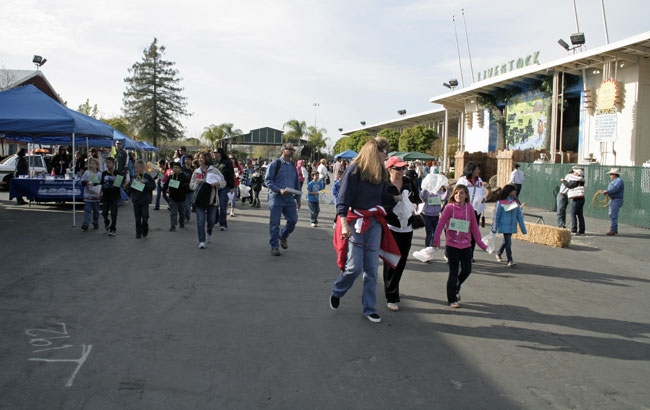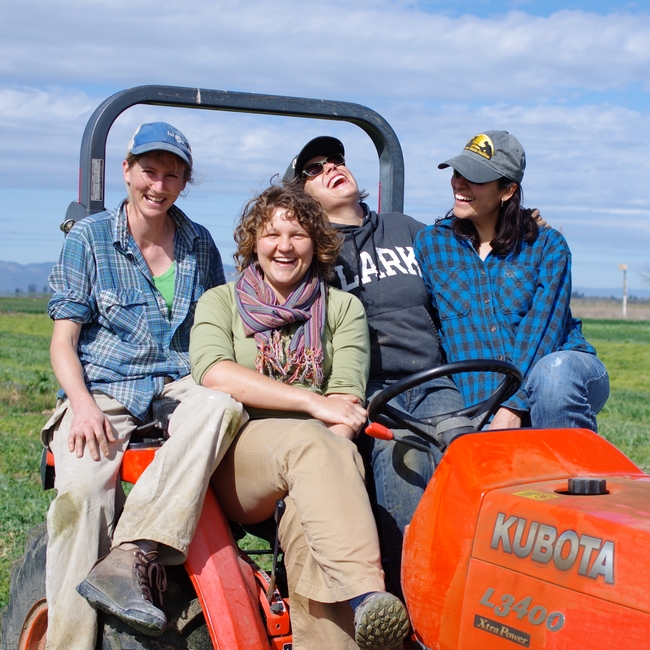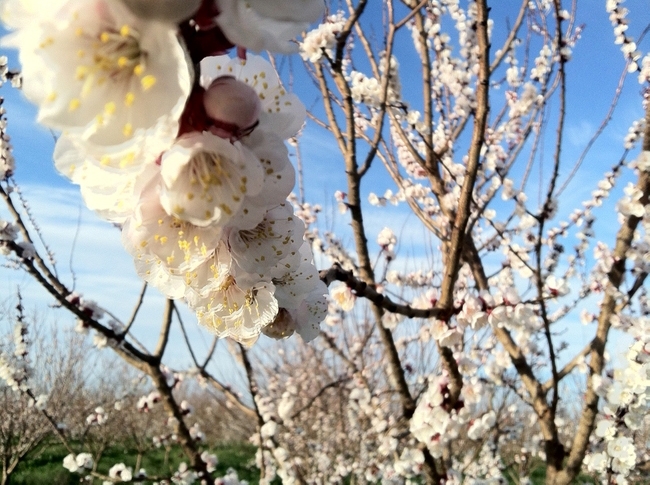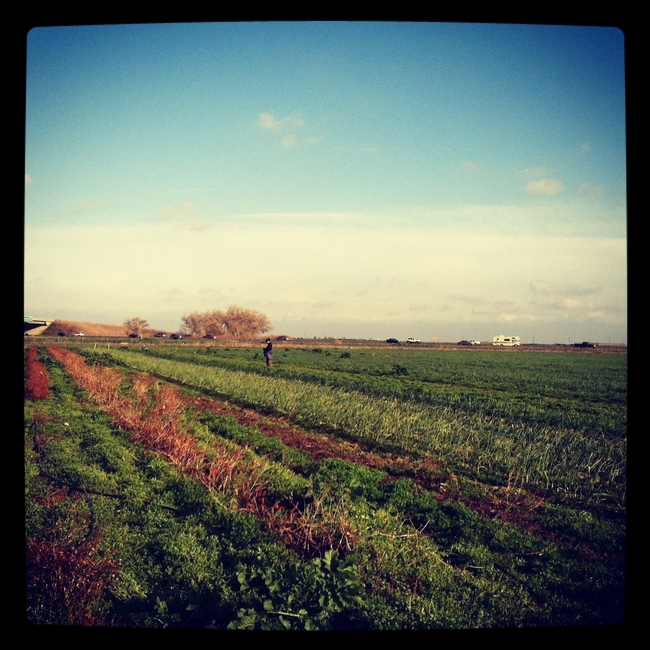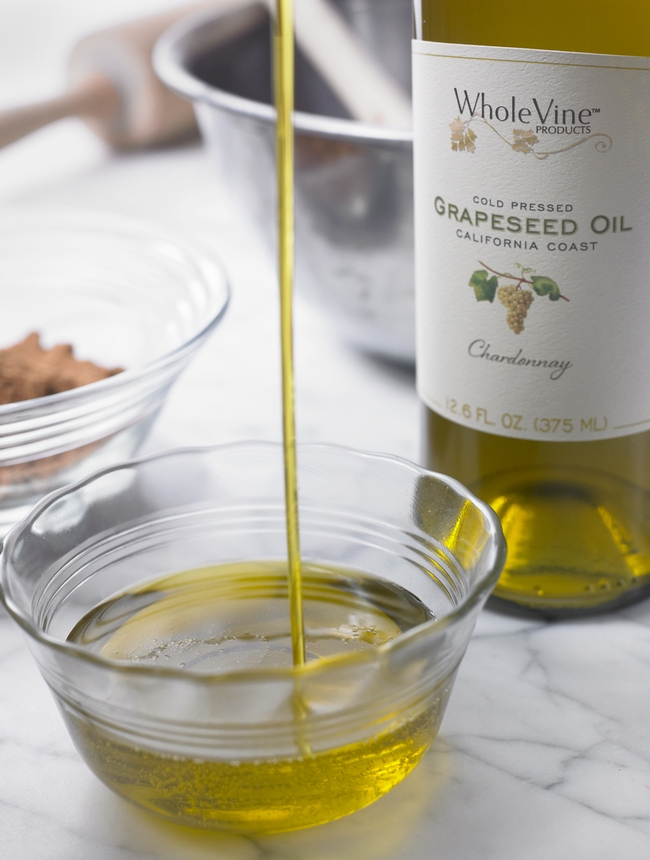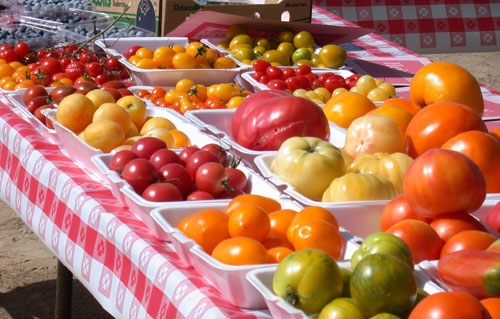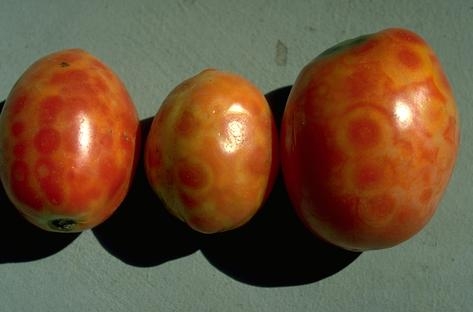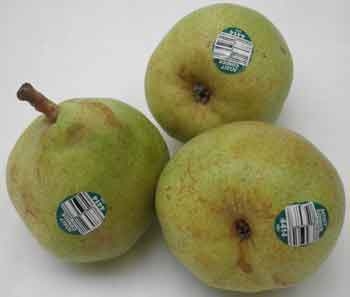UC Food Blog
Getting kids excited about 'anytime' foods
Children can eat a healthier diet by making some easy substitutions in their food choices, avoiding "sometimes food," like candy, soda and chips, and instead eating "anytime food," like fruits, vegetables and low-fat milk.
UC Cooperative Extension nutrition educators in Fresno County staged a skit at the Fresno County Food & Nutrition Day March 23 to reinforce these healthy eating messages. The event drew nearly 2,000 third-graders to the fairgrounds.
"Scarlet Strong," played by UCCE nutrition educator Nath Say, battled it out with "Rhonda Rotten Tooth," brought to life by UCCE nutrition educator Shawna Rogers.
Applause by the children gave Scarlet strength to knock down the unhealthful food Rhonda prefers - crunchy cheese sticks, chocolate chip cookies, candy, french fries and sugary soda - and encourage Scarlet to instead choose carrots, strawberries, bananas, sesame seed pretzels and milk.
The skit complements UCCE's CalFresh nutrition education program, which reaches out to children in schools where 50 percent or more of the students are eligible to receive free or reduced-price lunches.
Watch the skit in the three-minute video below:
The promise of peaches
Tomatoes grow fine in my Sacramento backyard. I can usually count on plenty of basil, more zucchini than the neighbors will take, some snow peas, chard and kale, a few small peppers and eggplants and whatever salad greens survive the slugs (in other words, lots of arugula). We have oranges and grapefruit, but I wouldn't even try to grow peaches or apricots. It takes a farmer to grow peaches. It takes a good farmer to grow good peaches. It takes a good farmer and good weather to grow Blenheim apricots.
Instead of planting a peach tree, I joined a fruit community supported agriculture (CSA) program, promising to pay $15 a week for a box of fresh fruit every week from June 7 until October 4. By joining I am agreeing to share the risk and the promise of the harvest of a four-acre fruit orchard with four part-time beginning farmers growing fruits and vegetables just west of Davis.
Emma Torbet and Sasha Klein started growing vegetables as The Cloverleaf at Bridgeway Farms about two years ago. Rich Collins, land-owner and sponsor of The Cloverleaf, planted the fruit trees four years ago but doesn't have the time to manage the orchard, so he leased it to the Cloverleaf farmers this year. Aubrey White and Marisa Alcorta joined as farm partners also this year. Together, the four women work long hours on weekends and evenings to farm an acre and a half of vegetables and the four acres of peaches, apricots, nectarines and figs. Like most beginning farmers, all four work full-time at other jobs; Torbet at the Russell Ranch Sustainable Agriculture Facility, Klein with the Farmer Veteran Coalition, White with the UC Agricultural Sustainability Institute, and Alcorta with the National Center for Appropriate Technology.
The Cloverleaf at Bridgeway Farms offers a chance that is, Aubrey White says, "both attractive and terrifying, with everyone trying to make it happen while keeping their jobs." The monetary investments were low, as they have no buildings or heavy equipment, and Collins offered a very attractive lease arrangement to encourage the new farmers. The vegetable land is certified organic and the orchard land is in transition to organic. The part that is terrifying is the risk of crop failure and poor yields that all farmers face.
The Cloverleaf farmers all have some farming experience, but the orchard presented new challenges. White started with the UC Master Gardener Program in Los Angeles, worked with urban farms and community gardens, and for two years at the UC Davis Student Farm. But, she says, taking on the orchard involved a "crazy different learning curve for three out of four of us." Even with all of her agricultural experience, she felt at a disadvantage not having a science background, particularly not having the soil science information to best manage the orchard.
Luckily, the new farmers found a mentor. Organic farmer Carl Rosato, owner of Woodleaf Farm near Oroville, is the soil scientist peach farmer that every beginning orchard manager would love to know. Rosato has taken on advising the Cloverleaf farmers as they learn to confront peach leaf curl and blossom rot by keeping the soil healthy and pruning the trees to ensure good air ventilation. Knowing that Rosato is involved gives me hope that we'll see some Blenheim apricots in the CSA box this June.
The original point of CSA programs was for the community (eaters) to share the risk of farming with the farmers, and to pay for a season's worth of produce up front to ease the cash-flow burden on the farmer before the harvest. In a pure traditional CSA, the farmer estimates the production for the year and sells shares in that production to as many families as the farm can be expected to feed. Each family receives a box of produce every week, with the full week's harvest divided up among the boxes. Some weeks there would be more variety than others; bounty and low yield would all be shared. Some years there would be good harvests and some years, poor harvests. The farmers are not at the mercy of the market, either wholesale buyers or competitive farmers' markets.
Most California CSA operators do not follow this traditional model, but sell to wholesale customers, restaurants, farmers markets and food processors in addition to the CSA customers. This means, in practice, that CSA customers do not share the full risk of the farm production and can expect a more consistent quantity in their box or basket each week. However, CSAs are an important and valuable part of most CSA operators' marketing plan. A UC study of several California organic farms selling through different marketing channels showed that the CSAs consistently returned the most profit to the marketing investment.
As a small farm with a young orchard, The Cloverleaf's fruit CSA still involves a little risk to the members. If the rain continues through June, as it did last year, we may not get those delicious Blenheims. Last year everyone lost them. But CSA manager White promises to give first priority to the CSA customers, with 25 to 50 percent of the fruit harvest going to CSA members. If needed, Cloverleaf will buy more blackberries from Collins or fill the boxes with the more successful varieties of peaches and nectarines.
In addition to the CSA, The Cloverleaf farmers will operate a farm stand, several U-pick days and a harvest festival this year, and sell fruit to several wholesale buyers. Just in case they don't have enough to do, they are considering introducing pastured chickens to the farm next year. The farm stand will open on Memorial Day at the Kidwell Road exit off Highway 80 between Davis and Dixon, and will remain open on Saturdays and Sundays until October. Information about the U-pick days and the harvest festival (and lots of other on-farm activities throughout California) will be listed on the UC Agritourism Directory, www.calagtour.org.
There might be a few shares left for the fruit CSA. For more information, visit the website or Facebook page of The Cloverleaf at Bridgeway Farms or email thecloverleaffarm@gmail.com. I'm looking forward to those peaches!
How waste becomes gourmet food
I attended the Fancy Food Show in San Francisco in January and I was delighted with the offerings from local companies near UC Davis. Since I attended this vast international exhibit, I have purchased several local products that I discovered at the show. The exhibit was so large, I was only able to see half of it in a day. I met Matthieu Kohlmeyer, the French CEO and General Manager of La Tourangelle, whose walnut oils are processed 15 minutes away in Woodland.
I was also impressed with Mezzetta pasta sauces from Napa. I have purchased their olives and fire-roasted peppers for years, so why did I fail to notice their pasta sauce among the endless brands on the shelves? Unfortunately, my favorite in their line, Puttanesca, was not on the shelf at my grocer, but I found the spicy Arrabbiata, my second favorite tasting at the show.
As I looked for the locals I looked in vain for a local grape seed oil. The Italians were selling grape seed oil at wholesale prices that were surprisingly low. Meanwhile, I knew that grape seeds in our nearby wine regions are still largely treated as waste, just as UC Davis olives were treated before our former grounds manager Sal Genito partnered with a local olive oil company to launch a gourmet brand of oil at UC Davis.
To my delight, Sacramento Bee Food & Wine writer Chris Macias featured WholeVine grape seed oil on the March 14 food page. Its parent company is a successful local start-up, SonomaCeuticals, Santa Rosa, who developed the process to extract the oil from local grapes.
Not surprisingly, UC Davis was involved. Sharon Shoemaker, director of the UC Davis' California Institute of Food and Agricultural Research (CIFAR), was interviewed about her role in helping SonomaCeuticals tap into campus expertise. WholeVine grape seed oil is cold pressed, allowing it to retain the natural flavors of chardonnay, zinfandel, reisling and other winegrape seeds. The flavor provides an added bonus to a naturally high smoke point and health benefits. This commands a higher price than imported oils and allows the firm to compete in this market.
Shoemaker and her program CIFAR (see-far) are champions of campus research. Since 1992, her dynamic energy has been sustained through private enterprises that pay for her business-friendly conferences and services to benefit small and large concerns. Rarely does the public see how often executives drop in to tap into UC Davis resources. This happens behind the scenes with little fanfare, except this time, when the nuances of a new product triumph came to light on the food page. All of us can now enjoy the benefits.
Tomatoes for flavor, for food and for everyone
Tomatoes are the No. 1 garden crop in America. Everyone who has a summer garden grow tomatoes. There are more blogs, forums, tweets, and garden club and café talks about tomatoes than any other garden vegetable. Tomatoes are used in so many recipes, and can be preserved so easily into so many products it just makes sense to grow them in your garden. The garden lore about growing tomatoes successfully abounds. And the really good new . . . the failure rate for tomatoes is pretty darn low. You may not get as many as you like but you will get some pretty much guaranteed even with the low yielding heirloom varieties.
The really hard part about growing tomatoes is trying to select the variety for your location, the preferred size of your tomato fruit whether it is a small, medium or large, a paste or slicing type, red or yellow or orange or striped, or to select for plant size and growth habit, such as suitable for containers or should make the priority disease resistance? Or should you just choose whatever the nursery has in stock?
The first consideration for variety selection should be climate. There are three basic tomato growing zones in California. Zone A is the coastal area of Santa Barbara south; it includes the coastal foothills, and mountain ranges from San Diego though Marin Counties and the foothills surrounding the Central Valley, Napa and Sonoma Valleys. These areas are typified by summer daytime temperatures are warm but below 95F. Zone B are the inland valleys and high and low deserts. This area has daytime temperatures that regularly exceed 95F. Zone C are the intermediate central and northern coastal areas; cool coastal valleys from Santa Maria north to the Oregon border and include the SF Peninsula. These areas have cool to moderate summers with evening temperatures in the 45-55F. While many varieties have been evaluated for their climatic adaptations, many have not so keep that in mind when selecting your varieties. Examples of each are in the table below.
|
Zone A |
Zone B |
Zone C |
Not yet evaluated |
|
Sungold Cherry |
Sungold Cherry |
Sungold Cherry |
Brandywine |
|
Ace |
Ace |
Carmelo |
Beefmaster |
|
Better Boy |
Bush Champion determinant |
Patio Hybrid |
Lemon boy |
|
Floramerica Hybrid VFFNASt |
Floramerica Hybrid VFFNASt |
Bingo VFT |
Roma |
|
Supersteak |
Early Pick Hybrid |
Champion Hybrid VFNT |
Goliath Hybrid |
|
Early Girl Hybrid VFF |
Shady Lady |
Dona |
Green Zebra |
|
Jackpot Hybrid |
Early Bush 76 VF |
Stupice |
Green Grape |
|
Whopper Improved |
Celebrity |
Legend |
|
Next is to decide how big you want your plants to grow. Determinant or “bush” varieties are those that grow to a given size (about 3-5 ft) and bear most of their fruit within about 4-6 weeks. If you like to can your produce, a determinate variety would be best since you harvest most all the fruit in a narrow window.
Indeterminate tomato varieties grow and set fruit all summer until they are killed by the frost. This type is good if you have the room to stake or trellis them and want a continual harvest. I like to plant some of each.
The last thing to evaluate in selecting varieties is disease resistance. One disease that really has become a problem in many gardens is tomato spotted wilt virus. (see picture, left). This disease is transmitted by thrips and causes the fruit to spot and become corky. Look for resistant varieties if you have noticed this problem on your tomatoes in the past. Fletcher, BHN444 and BHN1021 are resistant varieties and good quality fruit. For more information on management of Tomato Spotted Wilt Virus, go to UCIPM Website.
For more information on tomato culture and other pest problems, download our free 10-page leaflet Growing Tomatoes in the Home Garden.
California's delicious harvest season unfolds
Early spring can be an invigorating time of year, with lengthening days, blooming daffodils and fruit trees (and ski season still in full force). One of the best perks of the season is the availability of luscious strawberries, and tasty artichokes and asparagus picked from nearby farms, with flavor quality and price that reflects both in-season and local transportation benefits.
Depending on your location, farmers markets and pick-your-own farms will begin offering their wares within the next month or two. There are over 700 farmers markets in California. A wide variety of produce, from the exotic to the humble every-day variety, is available to entice you with its fresh beauty. We here in the West spend more annually on fresh produce at $511 vs. the national average of $429, wrote Roberta Cook, UC Cooperative Extension specialist in the UC Davis Department of Agriculture and Resource Economics, in “Eye on Economics: Much more than Dollars and Cents. Cook states that, “California produces half of the nation’s fresh fruits and vegetables and consumers here are privileged to have an abundance of high quality fresh produce over extended seasons due to California’s Mediterranean climate.”
Elsewhere in the United States “local” food markets are much less developed due to climate restrictions that limit production to a brief period in the summer and early fall; and the variety of products grown is only a fraction of the over 200 crops grown in California. While “local” production represents a rapidly growing share of U.S. agricultural sales, with direct-to-consumer sales more than quadrupling in the past decade, outside of California the share is still tiny.
There are few things as disappointing as biting into a piece of fruit that looks beautiful on the outside but just doesn’t deliver that burst of flavor, or cutting into a nice-looking vegetable only to find an unsightly defect inside. When I’m prowling through a display of fresh produce, I rev up all my senses into high gear and get up-close and personal with the fruit and veggie items on my list. I get busy feeling the weight-to-size ratio, gently (not too hard, mind you, or you’ll get a bad reputation with other shoppers) pressing to feel for firmness, looking at color, form, and stem separation area, and smelling the aroma. All of these things, and more, help provide clues about the quality inside.
Country of Origin Labeling (COOL) and Price Look Up (PLU) stickers
Other clues are often available about where and how your produce items were grown. For instance, in 2009 rules (affecting retail grocers) were adopted by the USDA mandating country of origin labeling (COOL), which required that retailers notify customers of the country of origin of all perishable agricultural commodities. Also offering insights into your produce selection is the Price Look Up sticker. Created by the Produce Marketing Association (PMA) in 1987 to create a standardized system to assist check-out clerks with looking up the produce items, it also indicates additional information such as whether it’s organic.
For instance, if your produce item’s sticker has a 4 digit code, it is “conventionally grown, but not organic.” If the code has 5 digits, and the first digit is a 9, the produce was organically grown. Usually the PLU stickers also include the country of origin in writing, but if not, this information should be displayed on the packing box or other store signage. Conventionally grown produce is recognized by scientists and regulators to be just as safe as organically grown and there is no evidence that it is worse for the environment. About 95 percent of retail fresh produce sales are conventionally grown and generally cost about 30 percent less than organics.
There are a number of resources that can help produce shoppers improve their savvy shopping skills:
From the Farm to Your Table: A Consumer’s Guide to Fresh Fruits and Vegetables, by James Thompson and Adel Kader. This 16-page booklet offers information on measuring quality; farm-based growing conditions, practices and harvesting; handling, transportation and storage; and selecting and storing good-quality produce for use at home. The table on how to select good-quality produce is especially helpful. ($7.00/copy)
Shopping for Fruits & Vegetables at the Fruits and Veggies: More Matters web site
Storing Fresh Fruit and Vegetables for Better Taste, a free downloadable poster from the UC Davis Postharvest Technology Center
i know produce, a comprehensive produce website developed by the Produce Marketing Association (PMA) that includes photo identification, written description, availability by location, nutrition information, storage/handling, and tips.


